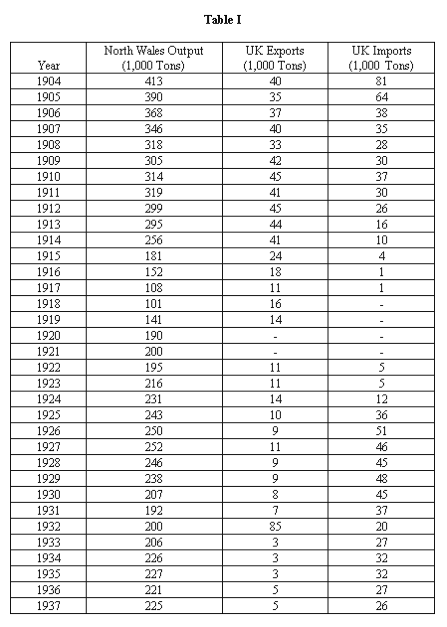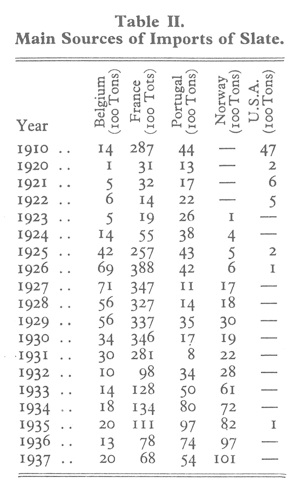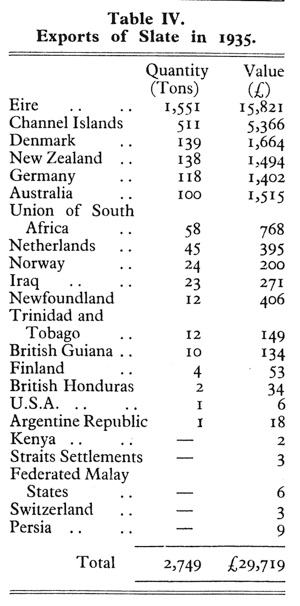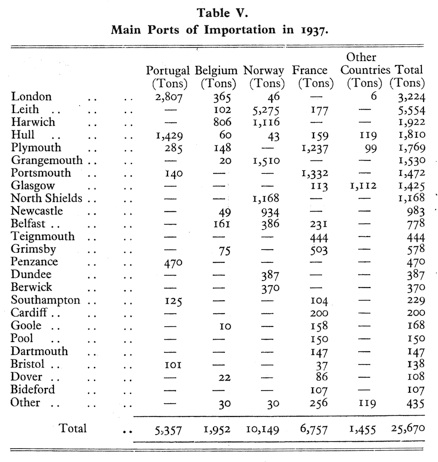Historical aspects of the Welsh slate industry
D Dylan Pritchard MA FSS
Historical aspects of the Welsh slate industry
D Dylan Pritchard MA FSS
In our last article we endeavoured to show why it is that the slate industry, with its rising costs of production, unprotected against foreign competition, and exposed to the aggressive competition of a multitudinous variety of substitutes, must at all costs avoid protracted industrial disputes. What~ ever may be the points at issue between employers and employees at any given time, the best interests of both parties will be served if those differences are resolved by negotiation or arbitration and not by resorting to strikes and lockouts.
We also showed how the elimination of the weaker economic units through cut‑throat competition had always meant a permanent decrease in the production capacity of the industry as a whole and how this fact, together with the inability of any single productive unit in the industry (for obvious technical reasons) to increase its output rapidly created, especially during building booms, conditions favourable to the importation of foreign slate and the increased use of substitutes, which was clearly detrimental to the interests of all concerned with the industry.
In this article we intend to trace the vicissitudes in British foreign trade in slate during the present century, more especially in the inter‑war period.
One of the pit‑falls into which students of foreign trade during this period almost invariably fall is to ignore the fact that prior to 1923 that part of Ireland now known as Eire was part of the United Kingdom and imports into Eire from foreign countries prior to that date were regarded as imports into the United Kingdom, whereas shipments to Great Britain from Eire were not regarded as imports but merely as internal trade ; from 1923 onwards, however, shipments to this country from Eire were regarded as imports because Eire was now a "foreign" country, and shipments there from this country were regarded as exports, whereas prior to 1923, such shipments had merely been regarded as internal trade within the United Kingdom. Ireland had always been an exceedingly good customer for Welsh slates but shipments of slate to Eire prior to 1923 did not appear as exports, where as since 1923 they appear as exports. Furthermore, Ireland had provided a market for large quantities of slate from countries other than Britain and prior to 1923 these appear as imports into the United Kingdom, whereas after 1923 they are not included in the trade returns. It is clear that to compare the annual Board of Trade returns of imports and exports of slate into the "United Kingdom" before and after 1923 is to compare in-comparables and is very misleading.
For our purpose a corrected series of annual returns have been compiled for the years 1904 to 1937 and are set out in Table I. Our corrected figures of exports from the United Kingdom include shipments from Britain to Eire throughout the period and exclude exports from Eire to countries other than Great Britain and Northern Ireland ; our statistics of imports exclude imports of slate from other countries into Eire throughout the period and include imports into Great Britain and Northern Ireland from Eire. What we have done is to take the actual Board of Trade figures for the period since 1923 and corrected the official returns for the period 1904 to 1919 in order to make the whole series of statistics comparable. Certain data which is essential for the compilation of the corrected figures for the two years 1920 and 1921 is missing so that statistics for those two years cannot be obtained.

Table 1 gives the annual output of dressed slate produced in North Wales for the period 1904 to 1937 inclusive, and also the annual volume of slate exported and imported from the United Kingdom (excluding the territory known as Eire) over the same period.
This table shows the great fall in the volume of slate production in North Wales in the decade preceding the last war. In the inter‑war period production fluctuated around the 220,000 tons level, which was substantially below even the 1914 output. The annual volume of slate exports remained fairly stable at about 40,000 tons between 1904 and 1914 but it has fallen progressively since so that only about 5,000 tons were exported in 1937. The volume of slate. imports fell from 81,000 tons in 1904 to 10,000 tons in 1914 and, after declining to vanishing point during the last war, importation increased to 51,000 tons in 1926 and then contracted to some 26,000 tons in 1937. In the inter‑war period the volume of slate imports has vastly exceeded the volume of exports.

Table II. shows the main sources from which slates were shipped to this country in 1910 and during the inter‑war period.
This table shows that in pre‑war days France was by far the most important source of imported slates, with Portugal and the United States a long way behind. Considerable quantities of slate were imported from France in the inter‑war period, especially between 1925 and 1931, the greatest quantity in any single year being 38,Soo tons in 1926. At the outbreak of the present war, France still remained the largest source of our imports but, as Tables II and Ill show, it was gradually surrendering pride of place to Norway. Indeed the most significant factor brought out by Table II is the remarkable and progressive increase in importation from Norway, amounting in 1937 to over 10,000 tons.

Table Ill gives a detailed return of the quantity and value of slate imported in 1937 from the different sources of supply.
Table Ill may be contrasted with Table IV which sets out the quantities and value of British roofing slates to various countries in 1935, (1937 statistics are unfortunately not to hand)

The only substantial outlet for our export is Eire but that country sends us as much slate as we send her. Germany our great pre‑last‑war market, in 1935 bought 45 tons of roofing slate from us. Denmark and Australia were also important pre‑last‑war markets but they only took 139 tons and 100 tons respectively in 1935 whereas the former had become an aggressive competitor in our home market. The United States had faded out of the picture both as importer and exporter. The position immediately prior to the present war was that to all extent and purposes our export trade has been "liquidated," whereas foreign slate producers have been able to dispose of large quantities of their product each year in the British market.
Part of the explanation why foreign slates find a ready market in Britain may be adduced from Table V, which analyses the returns of slate imports for the year 1937 and shows the quantity of slate shipped into the main ports of importation and the countries whence consigned.
It is interesting to note that Table V shows that the competition of foreign slates is especially keen in districts far away from the domestic producing centres, because railway freight charges are relatively high as compared with charges for transport by water. Nature has neither distributed workable deposits of slate on a lavish scale nor over a wide area and the slate producing areas are situated along the west coast, so that transport to some parts of Britain involve costly cross‑country railway journeys.

By far the greatest port of importation for slate in 1937 was Leith, which imported 5,554 tons, practically all of which came from Norway. Grangemouth, North Shields, Newcastle, Dundee and Berwick also imported heavily from Norway, whence the slates were shipped cheaply across the North Sea in British coal boats. Plymouth and Portsmouth imported heavily from France. London imported large quantities from Portugal. the data in Table V clearly establishes the fact that heavy railway transport costs gravely handicaps the domestic product in the more distant home markets and that cheap water transport gives the foreign competitor a differential advantage which is exploited to the full. In our next article we shall discuss the other factors underlying the importation of slate to this country.
Aspects of the Slate Industry 8: Foreign trade in slate in the present century: part 1
Quarry Managers' Journal December 1943
First series
Second series
Foreign trade 1
Third Series
Other slate information
National archive slate records
Links

Splitting and dressing slates Maen Offeren quarry 1925